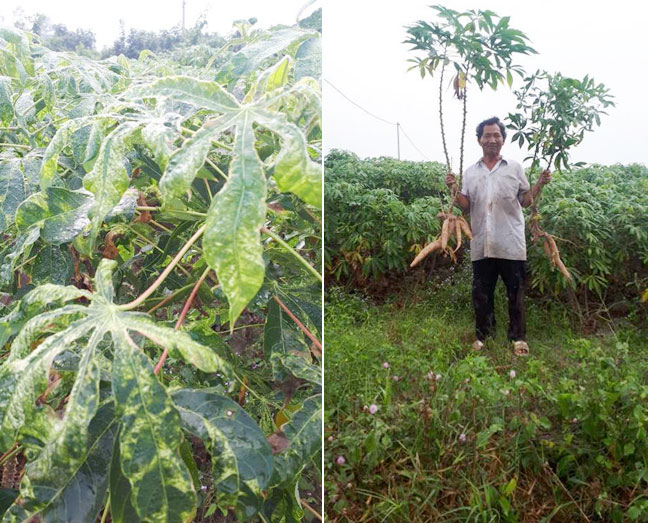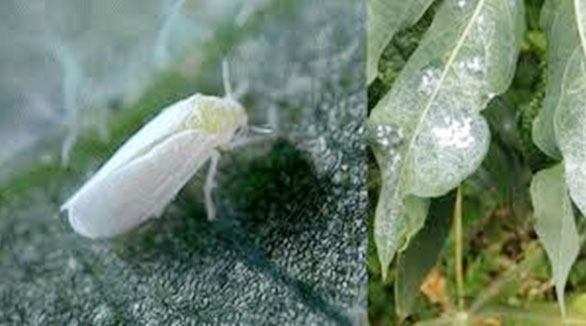|
Prevention And Control Of Leaf Mosaic Disease On Cassava
10/08/2021
BSc Nguyễn Kha Minh Tuấn Vietnam is one of the countries with the leading export cassava production in the world. In recent years, the epidemic situation has become very complicated, greatly affecting the yield and quality of this agricultural product, especially leaf mosaic disease. Currently, cassava leaf mosaic disease is spreading and becoming more difficult to control. Large cassava growing areas in our country such as Tay Ninh, Gia Lai, Binh Phuoc, Phu Yen, etc. all have very high infection rates. The main cause of disease transmission is the use of infected cuttings and whitefly is the intermediate host of the disease Causative agent: The disease is caused by SLCMV virus (Sri Lanka Cassava Mosaic Virus). Symptoms od disease : The common and recognizable symptom is the appearance of white, yellow or light green mosaics scattered all over the leaf surface, the leaf blade is warped, deformed and may be thicker than usual. The lower the plant and the lower the yield if the disease is infected early. Seeds cannot be sold in infected gardens. The disease can appear at most of the growth stages of the plant, if the diseased cuttings are used, the symptoms will appear as soon as they grow. For mature plants, infection will take longer to manifest and affect yield less, so disease prevention right from cuttings to seedlings is extremely important. Preventive measures: According to recommendations from experts and experiences of cassava growing farmers who have successfully implemented the following integrated measures: - Absolutely do not use infected cuttings, need to know the origin of the variety and do not use the seed in the infected area for the next crop. Sanitize the field after harvest. - Regularly visit the fields, especially in the early stages (when cuttings are placed until 2-3 months after planting), whitefly often hides on the underside of leaves, if diseased plants are detected, immediately uproot and destroy them at the same time. spray preventive product. Use 70o alcohol to disinfect farming tools. - Use varieties with relatively resistant disease such as KM94, KM414. Do not use varieties with high infection rates such as KM40, HLS11 - Note that while collecting seeds and stacking them into bundles to prepare for the next crop, some cassava’s sprouts will emerge first to attract whiteflies. Therefore, it is necessary to spray treatment when preparing cuttings similar to products such as: Brimgold 200WP with a dose of 14 grams / 16 liters of water or Osago 80WG with a dose of 10 grams / 16 liters of water. - Use insecticides with many outstanding characteristics and low resistance at the 25-day, 50-day and 75-day period after sowing, with one of the two optimal formulas as follows: + Formula 1: 14 grams Brimgold 200WP + 30 ml SK-Enspray 99EC Mineral Oil (final mixing, no need to increase dose), mixed in a 16-liter-tank of water. Pay attention to spray a lot of water, early morning and cool late afternoon is the best time. + Formula 2: 10 grams Osago 80WG + 30 ml SK-Enspray 99EC Mineral Oil (final mixing, no need to increase dose), mixed in a 16-liter bottle of water. Pay attention to spray a lot of water, early morning and cool late afternoon is the best time. Because the disease can spread quickly because whitefly sucks from diseased plants to healthy plants, when people use the above recipes, they should pay attention to tips for cassava growing households or other plants that are the host of whitefies such as cucurbits, tobacco, cotton, tomatoes, potatoes, chili peppers, etc., are around together to prevent it for a while. Wish the farmers a good season and good price. |
To prevent, in addition to plowing and burying weed seeds, collecting weed stalks and stumps left after tilling the land to burn, not letting weeds produce seeds in production fields, etc., the use of chemical products is still a measure. optimal because of its ability to thoroughly kill weeds, reduce labor and take advantage of more time than manual weeding.
Miner has the scientific name Phyllocnistis citrella Staint., family Phyllocnistidae, order Lepidoptera. The miner occurs in many countries in the tropics and subtropics. The main host of the miner is the citrus family - Rutaceae. In addition, the miner also attacks mangosteen and some other plants.
Adult is a small planthopper, with a body 2-3 mm long, the whole body is ash gray, slightly greenish, the wings are opaque with many small brown spots.Eggs are oval, 0.3 mm long, have a pointed end and are attached directly to the leaf surface, leaf axils.
Green bugs specialize in the fruit of citrus groups (oranges, tangerines, lemons, grapefruits, kumquats...), some people call them orange bugs, or orange suckers. Their scientific name is Rhynchocoris poseidon or Rhynchocoris humeralis.
In Vietnam, yellow leaf curl disease is very common on papaya trees, especially the disease is often severe in areas of high and continuous planting, areas with hot and arid climates. The disease has significantly reduced the yield and quality of papaya. Gardens that are infected early when the plants are young may not yield. However, up to now, many gardeners still do not know the cause and how to fix it.
Spider mites are common pests on citrus trees, especially in hot and dry climates that are suitable for spiders to grow and cause severe damage.The group of harmful spiders is usually very small in size, unlike the natural enemy spiders.
This group includes species that are generally very small in size, causing damage by sucking plant sap (on leaves, fruits, branches, stems).
There are many species of mealybugs present on the group of Oranges,Tangerines,Grapefruits and Lemons (Citrus), which can be divided into 2 groups:
+ Group of sticky mealybugs with common varieties such as Lepidosaphes, Aonidiella, Coccus and Saissetia.
+ Group of flower mealybugs with common genera and species such as Pseudococcus, Planococcus and Icerya purchasi.
Dry branches and berries disease often appear to be common damage on coffee gardens during the rainy season. The disease causes death of branchs, dry fruit, severely affects the canopy structure and coffee yield if not paid attention to prevention.
Pink disease commonly causes diseases on rubber plantations in the rainy season, especially on garden from 4-8 years old. This year, rubber has to go through a period of severe drought, weakening the tree, so now in tnshe rainy season it is easy to get infected. Therefore, it is necessary to pay attention to good management to avoid affecting the garden.
In recent years, the area of citrus has been expanded because it is a fruit tree with high economic efficiency. However, in order to sell at a high price, not only in quality but consumers also require the external beauty of the fruit, so pest management on citrus is a matter of great concern to farmers. The hot season is a favorable condition for thrips to develop and cause damage, affecting the commercial value of fruit.
- Headquarters
- SAIGON PLANT PROTECTION JOINT STOCK COMPANY
- RQ 1, Nguyen Van Quy St., Tan Thuan Ward, HCM City
- Tax code: 0300632232
- Tel: (028) 38 733 295 - 38 732 077
- Fax: (028) 38 733 003 - 38 733 391
- Website: www.spchcmc.vn - Email: info@spchcmc.vn
- SAIGON PLANT PROTECTION COMPANY
- SAIGON PLANT PROTECTION JOINT STOCK ENTERPRISE
- Lot C1-C3 Hiep Phuoc Industrial Park, Hiep Phuoc Commune, HCM City
- Tel: (028) 3873 4089 - Fax: (028) 3873 4086
- Affiliated Unit
-
- Quick Links
- Home
- About us
- Career Opportunities














